One of the biggest drawbacks to chartplotter navigation is that the size of the screen limits the amount of chart information that the viewer can see at one time. Within reason, a bigger display is always better when it comes to navigating.
The advantages of a bigger screen were clearly evident in our last test (August 2008), which compared two 12-inch-diagonal screens: the Garmin 5212 touchscreen and the Raymarine E120. In that test, we gave the Raymarine a slight edge for its networking capabilities and the fact that it is compatible with Navionics charts, our preferred chart group for most uses. The new touchscreen Garmin, however, was also highly rated and recommended for those who valued a bright, more water-resistant, high-resolution screen. At the time of the review, we had little long-term data on the Garmins touchscreen performance, another factor that influenced ratings. Since that test, weve put Garmin 5212 through some very hard use on one of our test boats, and it has held up very well for the past six months.
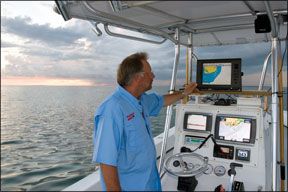
Earlier this year, we were able to test the latest 12-inch display from Simrad, the NX45. This allowed us another opportunity to answer the question, “Which big screen is best?”
To make things interesting, we pitted the NX45 head-to-head against the well-used Garmin 5212 to see if we could come up with a favorite.
How We Tested
The pair of big-screens multi-function displays (MFDs) were run through their paces aboard our Contender powerboat test boat in the Florida Keys. We checked day and night viewability and ran a series of functionality tests. As always, and most importantly in this review of large-screen displays, viewability played a major role in determining which unit was best.
Displays were rated under a wide variety of lighting conditions ranging from bright sunlight to night-time conditions. Each screen was looked at from various angles, with and without polarized sunglasses, and when applicable, using different background color palettes. After the sun went down, each unit was given a night-view rating based on the screen viewability during twilight and in darkness.
The Simrad display was mounted temporarily on a wood base using its accompanying bracket. The Garmin equipment is permanently installed on our test boat for long-term testing. Both systems had live GPS position information during testing. The Garmin system had pre-loaded Bluechart g2 cartography while the Simrad used a C-Map Max card covering the U.S. East Coast and Bahamas.
Each plotter was evaluated for user-interface. Intuitive software, easy entry of alphanumeric data, and dedicated function keys boosted a displays ratings.
Garmin GPSMAP 5212
Since our last look at the Garmin 5212 multi-function display in August 2008, we updated its operating software to version 4.60. Rather than rehash that review well hit the highlights of the unit, differences compared to the Simrad NX45, and bring you up to date on the latest software release enhancements.
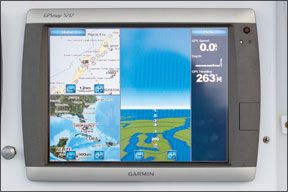
The Garmin 5212 comes preloaded with Garmin Bluechart g2 U.S. coastal cartography. It can also use Bluechart g2 Visions chart cards. Visions adds 3D views both above and below the waters surface as well as an extensive library of satellite and aerial photo coverage. Garmin recently released new versions of these charts after recalling previous versions due to discrepancies and omissions. This MFD is also available without preloaded cartography as the 5012 model. A conventional, non-touchscreen model is also available. Cold-weather sailors will want to opt for this option, as the screen will not respond to gloved hands.
This Garmin MFD can be set to dim and change color palette automatically. We use the auto system regularly and find it works well. In our last review of the Garmin 5212, we complained that it did not dim down far enough. That glitch was improved somewhat in a recent software update, but in our opinion, the Garmin 5212 could still dim further for night operations on a dark bridge.
In our opinion, this unit has the best data entry system weve seen on chartplotters weve tested. A full alphanumeric keyboard, not keypad, is displayed onscreen. Every letter and number has its own large pushbutton field. This made data entry fast and easy.
Garmin has increased the warranty period on the 5212 and other marine chartplotters to two years. This is a major enhancement of this product.
The Mark/MOB function on the 5212 also has been improved since our last review. The unit now has a Mark field displayed onscreen at all times. To activate the MOB, you press “Mark,” then press the “Man Overboard” field, which is displayed in red text. Once done, the unit builds and displays an MOB waypoint and shows course, distance, and cross track error back to the point in data boxes. When you are close to the point, distance is shown in feet. The unit also draws a course line and directional arrow graphically on the map page. This is an improvement, though wed still prefer single-button functionality.
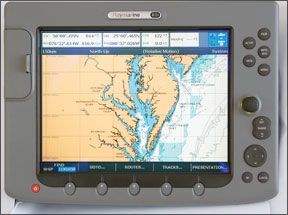
Garmin has added a measuring tool to the 5212 plotting function list that allows a quick measurement of distance and bearing between any two points. Touching the screen brings up the measure field onscreen for use. Data is displayed in the upper left data box.
Bottom line: Our initial concerns regarding the touchscreen interface (smudged screens, irregular responses) have not played out over the long term. The screen makes it especially easy when the time comes to do data entry. The longer two-year warranty is a bonus too.
Simrad NX45
Simrads parent company is Navico, whose other brands include B&G, Eagle, Lowrance, Northstar, Navman, and MX Marine. The Simrad NX45 can trace its origins back to a plotter from Navman, a brand that is no longer being marketed in the U.S. It also enjoyed an earlier incarnation under the Northstar label, before being updated.
The NX45 is a light unit compared to the Garmin. The display alone weighs only 6 pounds, 6 ounces. That is a couple pounds lighter than a comparably sized legacy Simrad display like the CX44.
The Simrad NX-series units are available in two screen sizes, 8.4 inches (NX40 )and 12.1 inches (NX45). These units use C-Map cartography and can communicate with other devices using the Simrad SimNet (NMEA 2000 network) or an NMEA 0183 connection. These include the GS10 GPS sensor, fuel monitors, certain engines, video, and an Automatic Identification System (AIS) unit. Three radar options are available, from a 2-kilowatt dome style unit to a 6-kilowatt, 4-foot-diameter, open array antenna. An integral sounder is included.
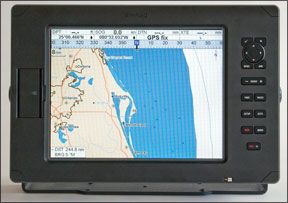
The NX45 is 15.2 inches wide, 10.1 inches high, and 3.1 inches deep. Thats just over two inches wider than the comparable Garmin. Width is nearly the same, while the Simrad is not nearly as deep as the Garmin. The display screen is 9.7 inches wide by 7.2 inches high and measures 12.1 inches on the diagonal. Resolution is a very respectable 800 x 600 pixels.
In daylight, the Simrad screen was not quite as bright as the Garmin and was slightly less sharp due to lower pixel resolution. When viewed straight on with polarized sunglasses, the screen darkens a bit. We tried the unit in normal and sunlight daytime palette colors and set the first depth limit at zero to lighten the screen further. This enhanced daylight viewing somewhat. We noticed some screen darkening when viewing from sharp side angles.
The NX45 screen brightness controls are accessed with a momentary press of the “PWR” (power) button. This triggers an onscreen menu showing the current level of brightness and a check box to select night mode. Screen backlight level can be adjusted using the cursor pad to one of 16 levels. Toggling down to night mode, then using the check key or the left arrow on the pad sets the choice. (The screen brightness can also be set via the main menu.) In the night palette, the background color changes to a black, and the digits and letters turn white. On the first unit tested, testers had trouble getting the PWR button to respond to every push (for setting screen brightness). The cursor pad was also balky. The right arrow refused to operate at least half the time testers tried to use it. A second unit worked flawlessly.
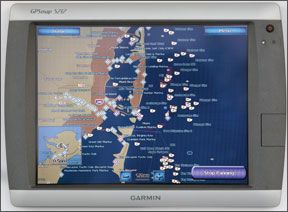
For evening and overcast viewing, we dimmed the NX45 in the normal day setting, then later switched to the night palette. At the very lowest brightness levels in night mode, the screen will go nearly black, good for preserving night vision. With the night palette selected, we noticed no screen darkening at side angles. Keypad lighting is linked to the screen brightness level and not separately adjustable. We rated night viewability as Good.
We tested the NX45 with software version 2.3.15 installed. This unit uses a number of dedicated function keys and multilayered menus for control and use.
Hitting the “FAV” button brings up five page choices. You can pick from a variety of pre-configured pages or build your own custom page set. Up to 4 windows and a data bar can be displayed simultaneously. The “WIN” key lets you select an active window with a single button push.
A waypoint can be saved at the present position with one push of the MARK key. Waypoints are identified with names up to eight characters long, one of 48 possible icons, and one of seven display colors. Waypoint type can also be shown as “normal” for a navigation waypoint or “danger” for a point to be avoided. A waypoint is created at the cursor position by placing it on the chart page, then hitting the “MENU” key and choosing a new waypoint. This unit has no alphanumeric keypad for data entry. Instead, you must use the cursor pad arrows to scroll through long lists of numbers and letters. In our opinion, this is a slow and arduous process.
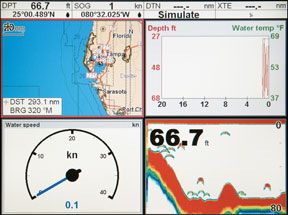
A new route is created by pressing the “MENU” key from the chart page and choosing a new route. Then you can move the cursor to a point and hit the check key to add the waypoint. You can continue this out to 500 waypoints.
Hitting the MOB key takes the unit into man overboard mode. First, an alarm will sound, and then users can choose to use the autopilot to navigate back or not. We chose not to. Next youll see blank chart page-switched to minimum range-and an MOB waypoint. Databoxes at the top only gave range to the MOB position in nautical miles. Bearing must be obtained from the blank chart page. Practical Sailor prefers a one-button operation that automatically gives the helmsmen all the necessary navigational data to reach the MOB position.
Chart redraws on the NX45 are lightning fast; it redraws the majority of the map instantly after a map range change. Minimum range can be set as low as .005 nautical miles.
The Simrad NX45 has an internal dual-frequency sounder capable of 600 or 1,000 watts of output power depending on the transducer used. You can display fish-finder data full screen or in a window. The window size is user adjustable with the split-ratio tool. It has all the top-notch fishfinder capabilities including A-scope and bottom lock. The unit has two automatic gain modes as well as manual.
During our testing, it marked all three submerged targets but only when using the dual-frequency display. Fine tuning with manual gain improved the view.
Bottom line: Overall, Simrad has done a good job developing a feature-packed MFD that can serve as the backbone for a marine navigational system. Just give the PWR button and cursor pad a good workout before setting out.
Conclusion
Despite high hopes, NMEA 2000-standard equipment does not always plug-and-play nicely together, so your own networking and chart preferences should be factored in. Simrad and Raymarine, with their wide, established marine product lines have a networking edge, but Garmin has launched a series of new products and is coming on strong. In the context of this test-with interface and screen display weighted heavily-Garmin looks very good.
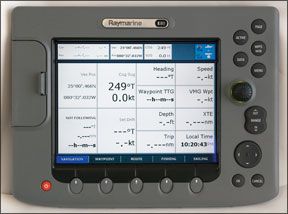
The Garmin bested the Simrad NX45 screen for daylight viewability, but not by much. It was just slightly brighter. In low-light conditions, Garmins automatic dimming system is handy, but the NX45 dims further, something offshore sailors will appreciate.
In our plotter interface tests, Garmins touchscreen was preferred for easy data entry, and the robust screen has proven itself in long-term use in the field.
The Garmin 5212 costs about $850 more than the Simrad NX45, but this includes U.S. coastal cartography and a touchscreen. The Simrad NX45 lacks onboard cartography but has an internal sounder, so effectively, each of these units has its niche.
In the end, the Raymarine E Series, with Navionics charts, a wide range of networking capabilities, and an interface that competes closely with the Simrad and Garmin, clings to our Best Choice rating, with the Garmin a Recommended pick and Simrad a Budget Buy. However, there have been rumors of Garmin purchasing Raymarine, which is having financial problems, and this too, bears watching.

































